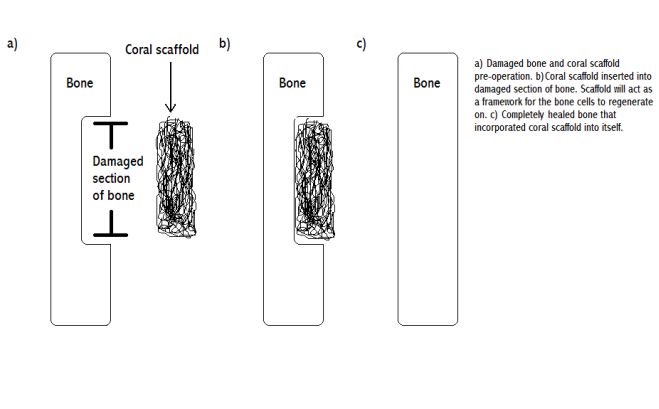When people think about medical advancements, their minds often revert to rare chemicals and intricate biochemical reactions (at least mine does). In my last blog post, I talked a lot about how some coral reef organisms are able to produce chemicals that can be used to treat a variety of human diseases. However, when we constantly are thinking in such precise detail, we can overlook simpler treatments that can be just as effective. Today, I want to talk about this phenomenon as it relates to medical uses of coral, specifically with your body’s durable framework: bones.
Bone grafting is a surgical process whereby damaged bone is replaced with healthy bone in some area of the body; the graft then integrates together with existing bone, eventually biodegrading away.¹ For a long time, bone grafting was a very consequential procedure; often to avoid rejection from the immune system, grafts would have to be take from some other area in the same individual (for example, bone could be taken from a femur in the leg to replace a diseased bone in the arm). However, this meant multiple different surgeries were usually necessary, which led to more complications and longer periods of postoperative therapy.
In the 1980s, Professor Eugene White had a revelation while scuba diving in the South Pacific; he realized he could use coral skeletons as bone grafts.² This would decrease both the number of surgeries and the time of postoperative therapy. He combined the coral skeleton (made of calcium carbonate) with heat, water, and phosphates to produce hydroxyapatite, the same chemical compound that comprises human bones (Figure 1).¹

Figure 1: Diagram of the formation of human bone via hydroxyapatite crystal deposition (McGraw-Hill)
For a long time, scientists have noticed the chemical and structural similarities between coral and bone, especially corals of the genus Porites (Figure 2).³ Numerous studies have indicated that coral grafts are able to function as “adequate carrier[s] for growth factors and allow cell attachment, growth, spreading and differentiation.³”

Figure 2: Comparison between hydroxyapatite made from a coral skeleton and an actual human bone. Both materials are durable and porous, allowing coral skeletons to act as effective bone grafts. (Mueting Media)
There was only one problem: this bone-like coral compound failed to biodegrade completely as new bone formed, leading to some unfavorable complications. As a result, coralline grafts were limited to very specific surgeries in certain situations.¹² However, a team at Swansea University in the United Kingdom found a possible solution to this issue.4 Instead of simply transforming the calcium carbonate coral into hydroxyapatite, they covered a calcium carbonate scaffold with a layer of hydroxyapatite to form a material called coralline hydroxyapatite/calcium carbonate (CHACC). Unlike pure hydroxyapatite, CHACC was found to completely biodegrade as bone growth occurred, which is ideally how a tissue scaffold functions (Figure 3).

Figure 3: Diagram of bone regeneration using a coral scaffold. The coral scaffold eventually completely integrates into the regenerated bone. (Stanford University)
Further clinical trials of this new treatment are in progress, but CHACC may be a huge development in the field of orthopedic surgery, significantly lowering the rate and length of postoperative complications. So the next time you twist your ankle, just remember that coral may become your new best friend.
References:
¹Agnew, M. (2014, October 21). Sea Coral: It’s (Soon to Be) in the Bones. Modern Farmer. Retrieved from http://modernfarmer.com/2014/10/sea-coral-soon-bones/
²Fessenden, M. (2014, October 23). Sea Coral Makes Excellent Human Bone Grafts. Smithsonian Magazine. Retrieved from http://www.smithsonianmag.com/smart-news/sea-coral-makes-excellent-human-bone-grafts-180953121/
³Demers, C., Hamdy, C.R., Corsi, K., Chellat, F., Tabrizian, M., & Yahia, L. (2002). Natural coral exoskeleton as a bone graft substitute: a review. Biomed. Mater. Eng. 12(1): 15-35.
4Paddock, C. (2013, November 2013). Bone grafts may be better with new sea coral material. Medical News Today. Retrieved from http://www.medicalnewstoday.com/articles/269512.php

